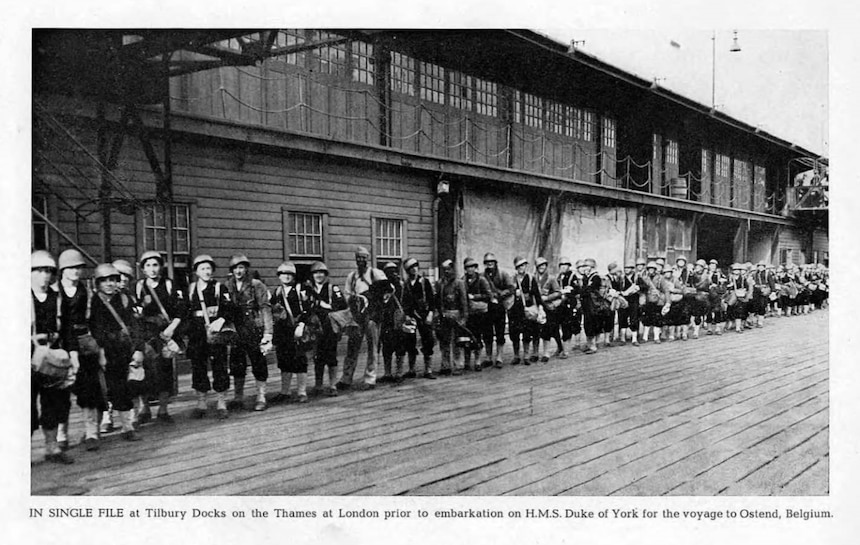Consolidated by U.S. Navy Seabee Museum, Naval History and Heritage Command
April 23
1971: The flag of Naval Mobile Construction Battalion (NMCB) 3 was relocated from Camp Haskins South, Da Nang, Republic of Vietnam (RVN) to Construction Battalion Center (CBC), Port Hueneme, California.
April 24
1945: The 69th Naval Construction Battalion (NCB) was the only full battalion assigned to Germany during the Second World War. On April 6, 1945 the first echelon of the 69th NCB left London, England for Ostend, Belgium, where they docked on April 7. The next day the men and equipment left Ostend as part of a convoy, crossed Belgium and part of Holland, and then crossed the Mass River near Venlo, Holland. The Seabees moved to Verden, Germany on April 24, and after the fall of Bremen on April 27 they proceeded to that city. It was here that the first echelon was joined by the rest of the battalion. After setting up camp at Lettow-Vorbeck-Kaserne, a few miles outside of Bremen, the Seabees immediately set to work re-roofing buildings where artillery had made huge gaps, installing plumbing and lighting, setting up shops and offices, and installing and repairing power lines. Seabees from the battalion repaired harbor facilities at the nearby port of Bremerhaven.

180420-N-ZY182-16366.png
1968: NMCB 9s advance party, consisting of one officer and 35 enlisted personnel, returned to Naval Air Station (NAS), Point Mugu, California on C-118 aircraft from Da Nang, RVN.
1970: Seabee Team 0413 arrived at their deployment site on Kusai Island, Ponape District, Trust Territory of the Pacific Islands (TTPI).
April 25
1945: ACORN 46 decommissioned and Naval Air Base Marpi Field, Saipan commissioned. (Used during World War II, an ACORN was a tailored unit designed to carry out the rapid construction and subsequent operation of a landplane and seaplane advance base. Each ACORN had a construction battalion attached to it, as well as trained personnel to operate the control tower, field lighting, aerological unit, transportation, medical, berthing, and messing facilities. A Construction Battalion Maintenance Unit (CBMU) also accompanied each ACORN to maintain the base after the initial construction was completed and the construction battalion had been withdrawn. During the war, ACORNs were sent to such places at Guadalcanal, Espiritu Santo, Green Island, Rendova, Treasury Island, and Majuro.)
1946: 93rd NCB inactivated at Samar, Philippines.
1965: As NMCB 10 prepared to mount out from Okinawa for the RVN, planning groups of two officers and three enlisted men from NMCB 9, and three officers and three enlisted men from NMCB 3, arrived at Danang to perform preliminary engineering and material procurement for Seabee projects then being programmed and scheduled for I Corps (ICTZ), Vietnam.
1967: NMCB 11 main body departed from Point Mugu Naval Air Station, California aboard MAC C-130 aircraft for Dong Ha Forward Combat Base, RVN.
April 26
1943: 9th Special NCB commissioned at Naval Construction Training Center (NCTC) Camp Peary, Magruder, Virginia.
1967: NMCB 11 main body consisting of 16 officers and 637 enlisted personnel deployed from CBC, Port Hueneme, California to the Dong Ha Forward Combat Base, RVN, via 11 Military Airlift Command C-130 aircraft.
1970: Seabee Team 0412 with Lt. j.g. J.A. Werner, Civil Engineer Corps (CEC) as Officer in Charge (OIC) departed CBC, Port Hueneme, California for training and indoctrination on Guam, before proceeding to their final deployment site on Koror Island, Palau District, TTPI.
1971: Seabee Team 4006 departed Davisville, Rhode Island for reassignment to OIC, Naval Construction Battalion, Pacific Fleet (CBPAC) Detachment (DET) RVN and deployment to Tan An, RVN.
April 27
1969: Disaster strikes area in and around ammunition supply point (ASP) 1, Da Nang when it erupted, as if it was a volcano. This was the largest ASP in I Corps area. NMCB 4 provided firefighting detail to assist NMCB 5. NMCB 5s Camp Hoover was adjacent to the huge ASP. NMCB 5s Camp Hoover was 90 percent destroyed; however, only two Seabees were wounded due to the immediate action taken during the initial explosions.
April 28
1943: 71st and 74th NCBs commissioned at Camp Peary, Magruder, Virginia.
1961: NMCB 9 was chosen to receive the first Peltier Award. Named in honor of Rear Admiral Eugene J. Peltier, a former Chief of the Bureau of Yards and Docks, the award is given annually to the most outstanding Seabee battalion. The Society of American Military Engineers presented the award, in association with the United States Navy.
1967: NMCB 11, the first battalion to be deployed to the Northern I Corps, commenced arriving at the Dong Ha Forward Combat Base, RVN.
1968: Lt. Cmdr. W.A. Simmons, CEC, relieved Cmdr. G.H. Brown, CEC, as executive officer, NMCB 71.
1971: NMCB 62 advance party, first and second flights, arrived at Camp Moscrip, Roosevelt Roads, Puerto Rico with 2 officers and 102 enlisted men.
1971: Seabee Team 0519 departed the continental United States (CONUS) enroute to the TTPI.
April 29
1965: NMCB 10 departed Okinawa via Navy ships (2 LSTs, 1 LSD, and 1 AKA) for Chu Lai, RVN.
1968: Seabee Team 1012 departed CBC Port Hueneme, California with 13 men for Thailand.
1971: NMCB 1 advance party departed Roosevelt Roads, Puerto Rico for Davisville, Rhode Island. Seabee Team 4005 departed Davisville, Rhode Island for reassignment to OIC CBPAC DET, Guam and deployment to Truk, TTPI.